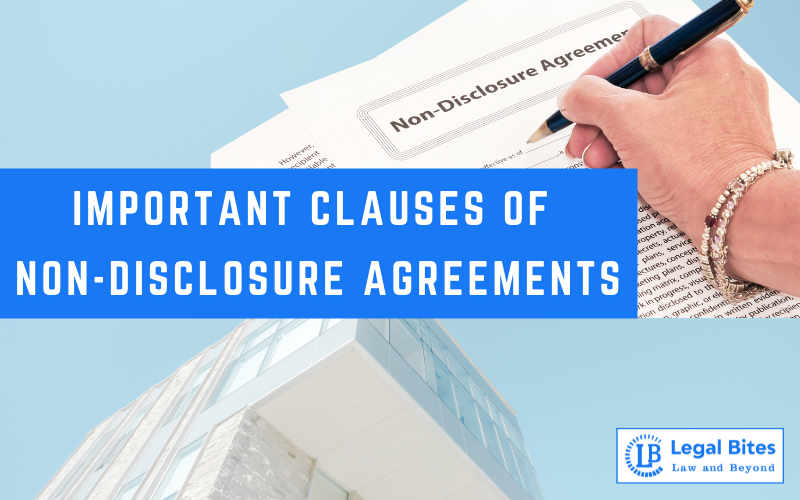Important Clauses of Non-Disclosure Agreements
In this article, we would look into the Important Clauses of Non-Disclosure Agreements. I. What is a Non-Disclosure Agreement and why is it important? On the backdoor of every enthralling start-up company, there is an idea at rock bottom that seeks a tangible form in order to be protected from the world trying to re-create or copy it.… Read More »
;
In this article, we would look into the Important Clauses of Non-Disclosure Agreements.
I. What is a Non-Disclosure Agreement and why is it important?
On the backdoor of every enthralling start-up company, there is an idea at rock bottom that seeks a tangible form in order to be protected from the world trying to re-create or copy it. For this intricate reason, non-disclosure agreements or confidentiality agreements become the need of the hour.
Non-disclosure agreements are generally signed between two parties/organizations/ individuals to enclose the agreed consent of the intellectual property of any nature involved between them. It is to ensure that the information shared between two parties in a specific period of time is not disclosed to any third party during the course of the engagement.
In this article, we would look into the clauses involved in non-disclosure agreements:
Confidential Information and its interpretation
The foremost and the first clause is the foundation stone on which an agreement is built to decide what exactly would they like to be protected with the signing of these agreements. The knowledge that is bound to come under the reach of the public domain would not come under this definition. Also, the information that is of any relevance to the nation and state’s functioning can also not be kept undercover.
This clause, in any circumstance, cannot infringe with any other provision provided in law. Every minuscule part of the information that can result in a subject of discourse in the forthcoming future has to be a part of this clause. As a concluding note in this clause, parties can also decide on the mode in which they would like to transfer the information or data created or researched during their engagement.
Use of Confidential Information
The second aspect as a clause involved in the aforementioned agreement is how the signing parties can use the confidential information involved. It is also one of the parts in the agreement out of which the major disputes arise. The tricky facet is due to the subjectivity and open-ended interpretative language inherently used in the clause. Before putting a lock onto how and where the information can be shared, it is pertinent to be prompt as to what is included in it.
Secondly, the use of this kind of information falling under the purviews shall not be detrimental to any party involved or the business conducted by them. Hence, this clause covers all trade secrets, modes of transferring information or creating secondary profits using the knowledge and information provided under the non-disclosure agreement.
Obligation to the disclosure of Information
This clause is partially opposite to the previous ones. It specifies the information that parties are obliged to share/disclose with each other either before the signing of an agreement or while the agreement is being signed. This can be the situation where one of the parties is a state or any government body where the legal authorized person or administration can ask for information required before walking into an agreement.
Remedies and Legal Resorts for Breach of Agreement
Each Non-disclosure agreement is required to include such a clause that accounts for the remedies/ solutions in case any of the involved parties deem to breach the clauses of the agreement they signed. The other party against whom the breach is caused has certain legal resorts differently put out in the legal system around the world. This clause is supposed to include all possible and plausible situations where the breach can be conducted, and also it sets out the remedies of the party in a justified and equitable manner.
This predicament certainly helps both parties to avoid long litigation battles in the court of law. Generally, there is an arbitration clause explaining the same.
Dispute Resolution and Jurisdictional Clause
The disputes and remedies as discussed in the previous clause lack the part where the jurisdiction is unclear. Arbitration is the most cost-effective method to save time and solve disputes between corporate giants and parties since involvement in court cases will only cause monetary harm to their business. It is a legal requirement to have a clause including how an arbitrator shall be appointed and what will be the powers of the arbitrator.
The jurisdiction clause elucidates the courts in a particular city that shall have the presiding power over the laws dictated for the same. This clause also determines that the jurisdiction of solving any particular dispute will be vested specifically to the court of the city specified in the clause. It becomes highly important to draft this clause with utmost clarity in the case where both the parties belong to different countries and one party of the either is from a foreign country, as if the same is not clarified, the legal battle will be financially heavy on both sides and will be time-consuming.
II. Conclusion
NDAs are designed and formulated through a legal framework to protect the misusing of information disclosed between mergers, acquisitions, and coalitions of different corporate firms or individuals. The only problem with these agreements is if any loophole is found in the agreement, the cost of it can sometimes be burdensome. Therefore, this is why it is advised to hire a legal professional to draft a non-disclosure agreement.
References:
- Jack McClure, Key Clauses in an NDA, Available Here
- AXIAL, 9 Clauses to Include in Every NDA, Available Here
- Non Disclosure Agreement, Available Here

